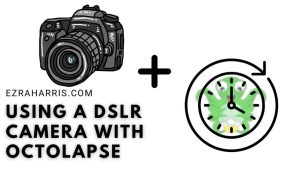Recently I bought a used Canon SL1 camera; it’s an old but great camera to use as a webcam or any general-use camera taking. One benefit is that it works with a lot of software using the USB port to capture a live video feed from the camera. When using the USB port it does have a bit of delay between the camera and the live feed, but it isn’t super noticeable in recordings.
I also discovered it works with Octolapse, a plugin for taking seamless-looking time-lapses of 3D prints. Following a tutorial by the creator of Octolapse (FormerLurker), I started setting up my camera with my Octoprint server.
The tutorial starts with the initial installation of the main program to interface with the camera. gPhoto. gPhoto supports a wide range of cameras, including my camera, which can File transfer, live view, and capture photos or videos.
What is gPhoto?
gPhoto is a set of software applications and libraries for use in digital photography.
gPhoto Wikipedia
With the installation, I generally followed the provided steps. Updated any updates that my Ubuntu server needed, updated Octoprint. When installing gPhoto, I had to use the “alternative instructions” since I didn’t run my Octoprint server on a Raspberry Pi, the structure of Linux flavors and different device configurations can make it differentiate the process configuring scripts and general directory locations.
Next is editing the “sudoers” file. It is similar to the standard setup, but instead of the regular path, I used the provided command to find the install directory where gPhoto was installed. I also used the output inside the line of code I needed to insert into the last line on the file.
whereis gphoto2
output:
gphoto2: /usr/local/bin/gphoto2After that, I can test gPhoto with a snapshot command; surprisingly, it worked! I heard the audible click, and it saved a picture to my server. Once that is set up, the next step is to create a script for the plugin to run in Linux that holds a picture, deletes it from the original SD card, and saves it to where the snapshots need to be stored to later process the whole timelapse video.
The script included with the tutorial works out of the box for me, thanks to FormerLurker’s documentation.
After that, I add it to the plugin’s configuration. Which also went well. I continued the guide with “Configuring a DSLR camera,” After which I started a print, and the final result after rendering is below:
One issue after rendering, which I could only fix by uploading it to YouTube, was the encoding and format of the rendered video. VLC media player says its renders at 4K, meaning 4000 pixels across. For some reason, my computer could not play 4K in the regular Windows media player or even my other video players without rendering it at 1/16’s quality. This may be due to the lack of support in my computer’s GPU (Intel Arc A370M Laptop GPU), but I’m unsure. But I can change that in Octolapse’s settings when it renders the final video. The F-stop was also not set correctly, which I can adjust in the camera’s menu.

Leave a Reply